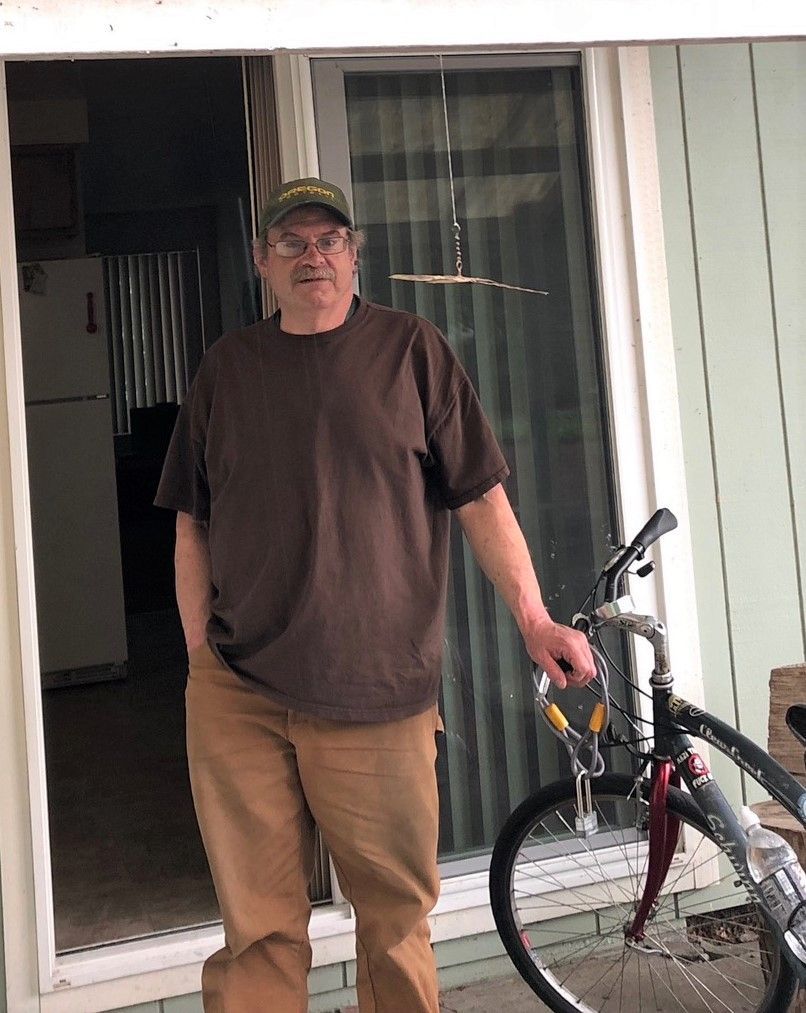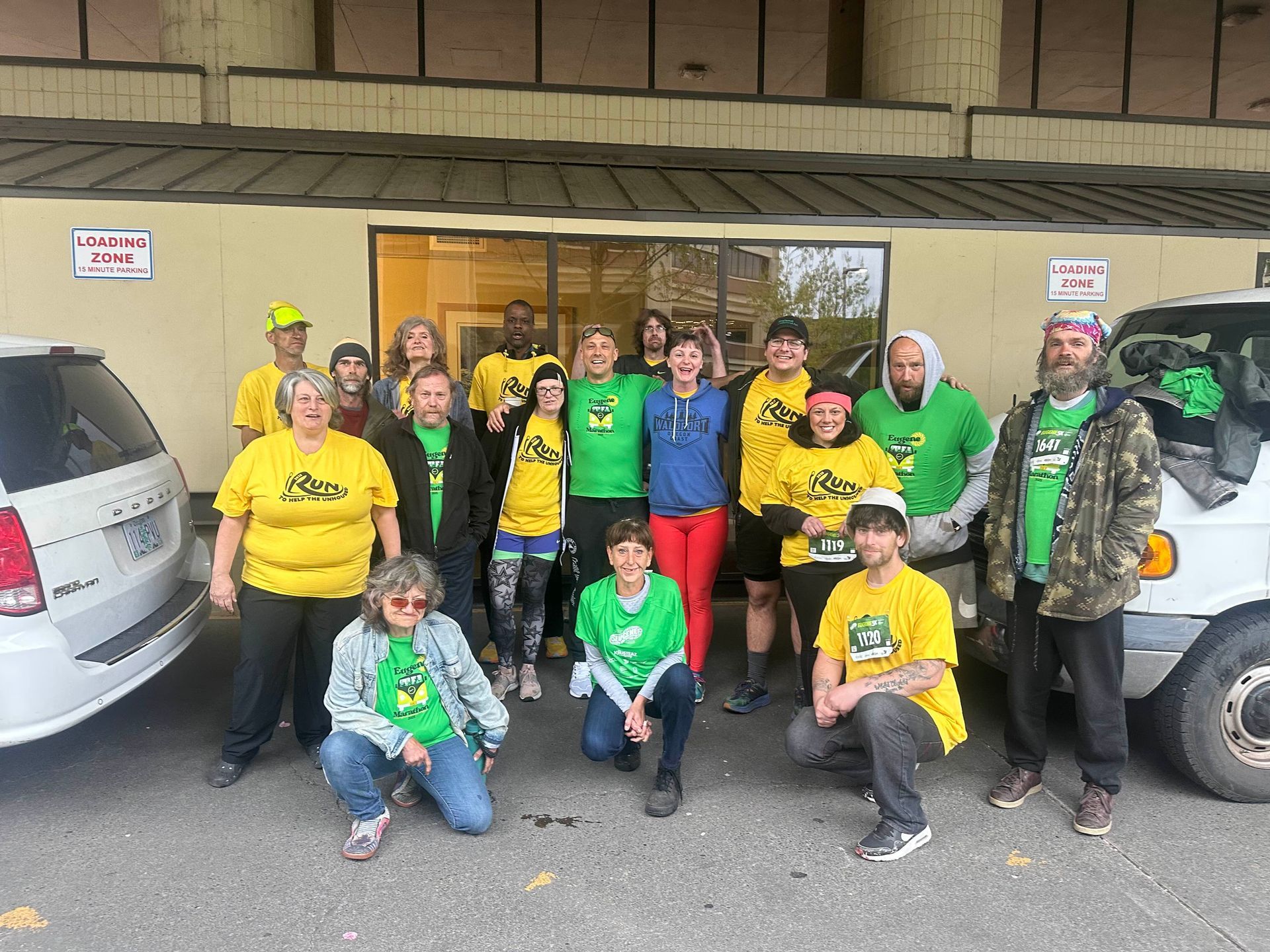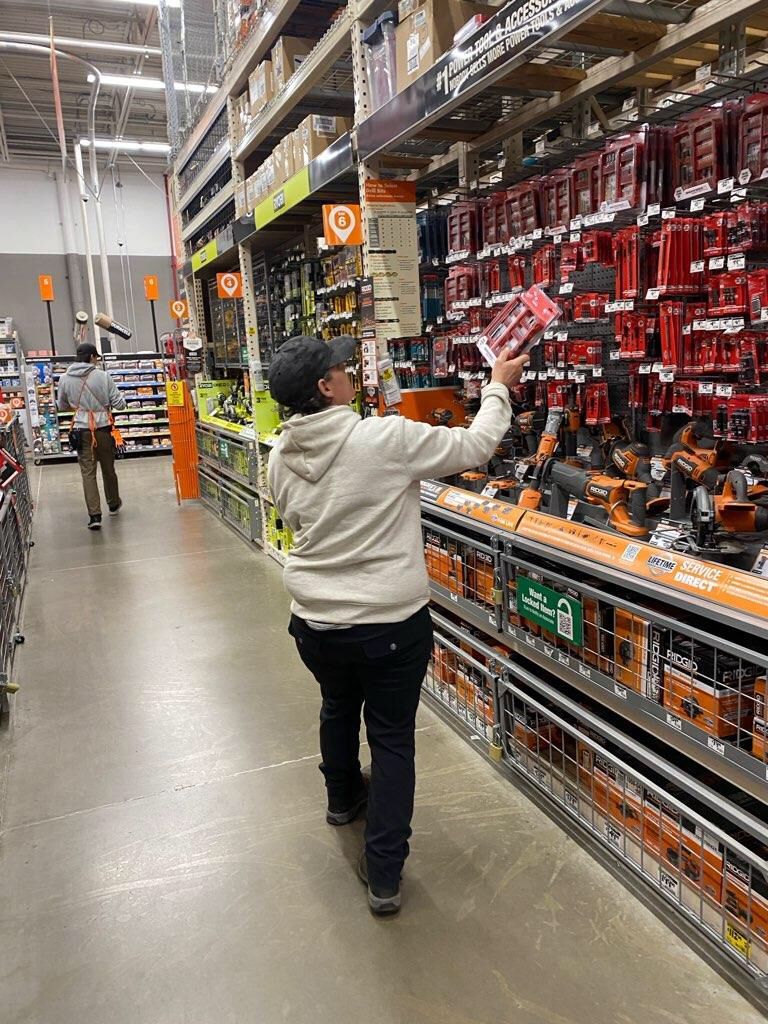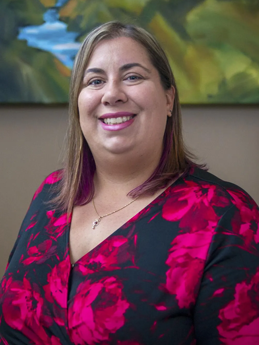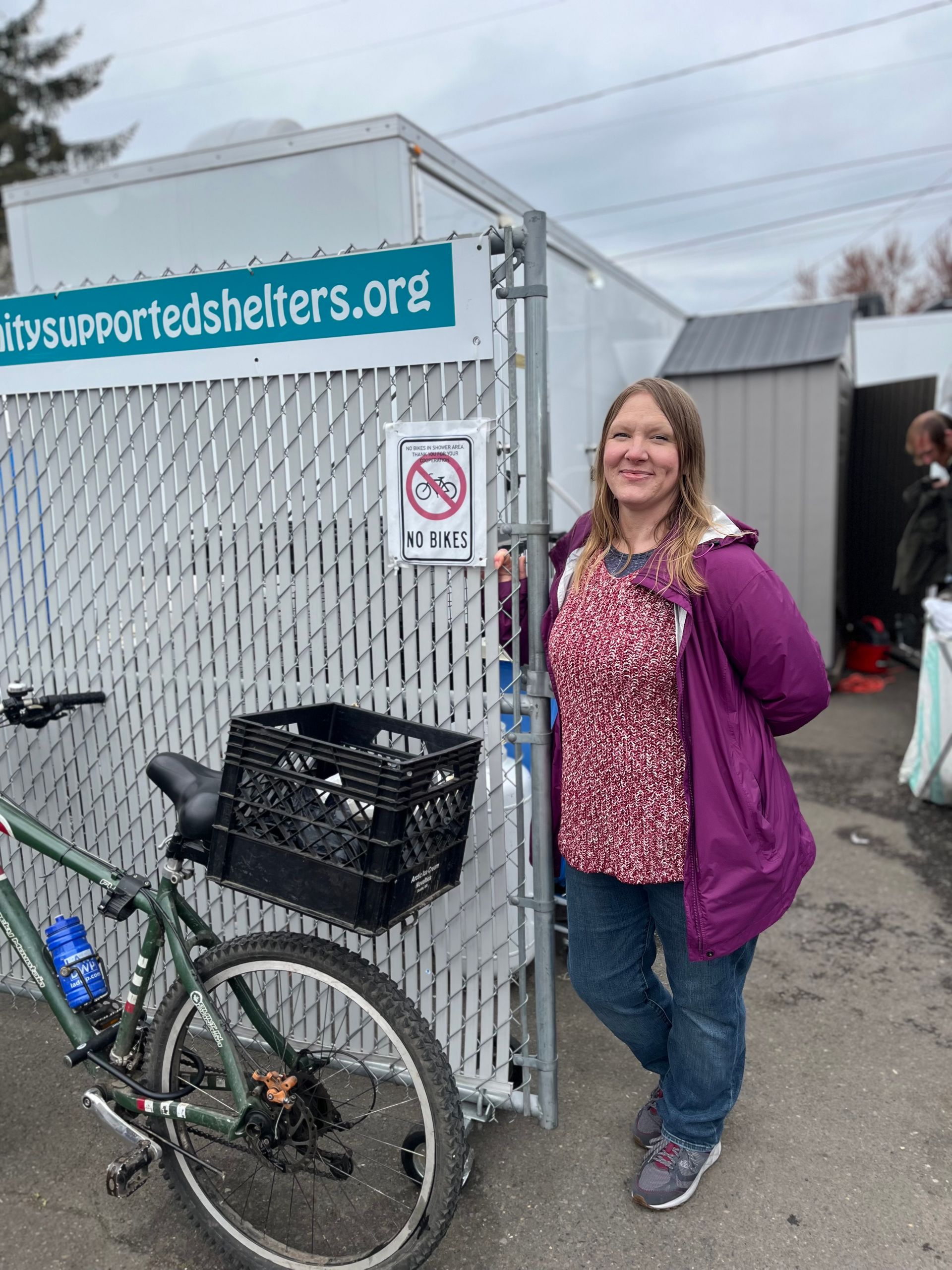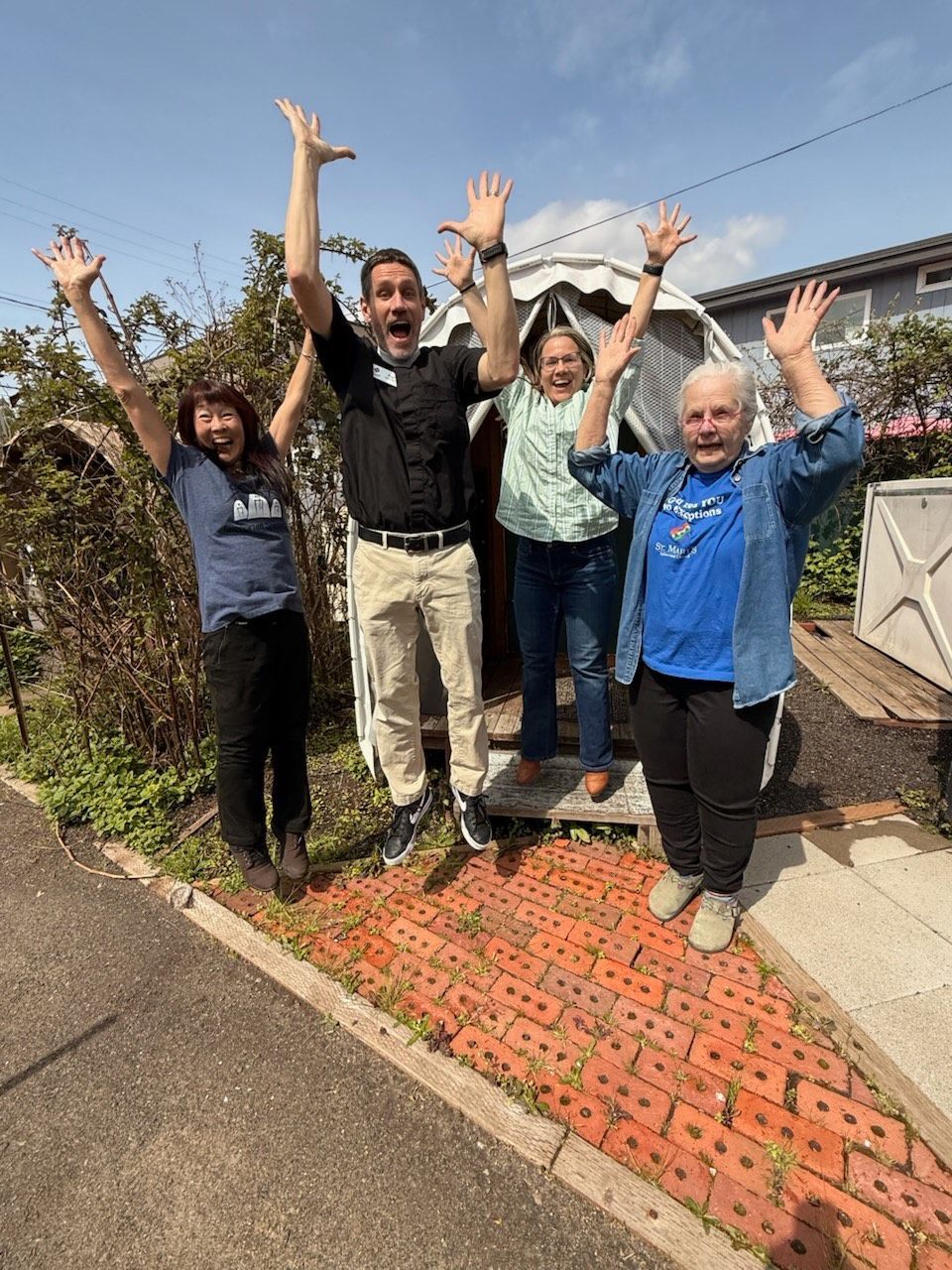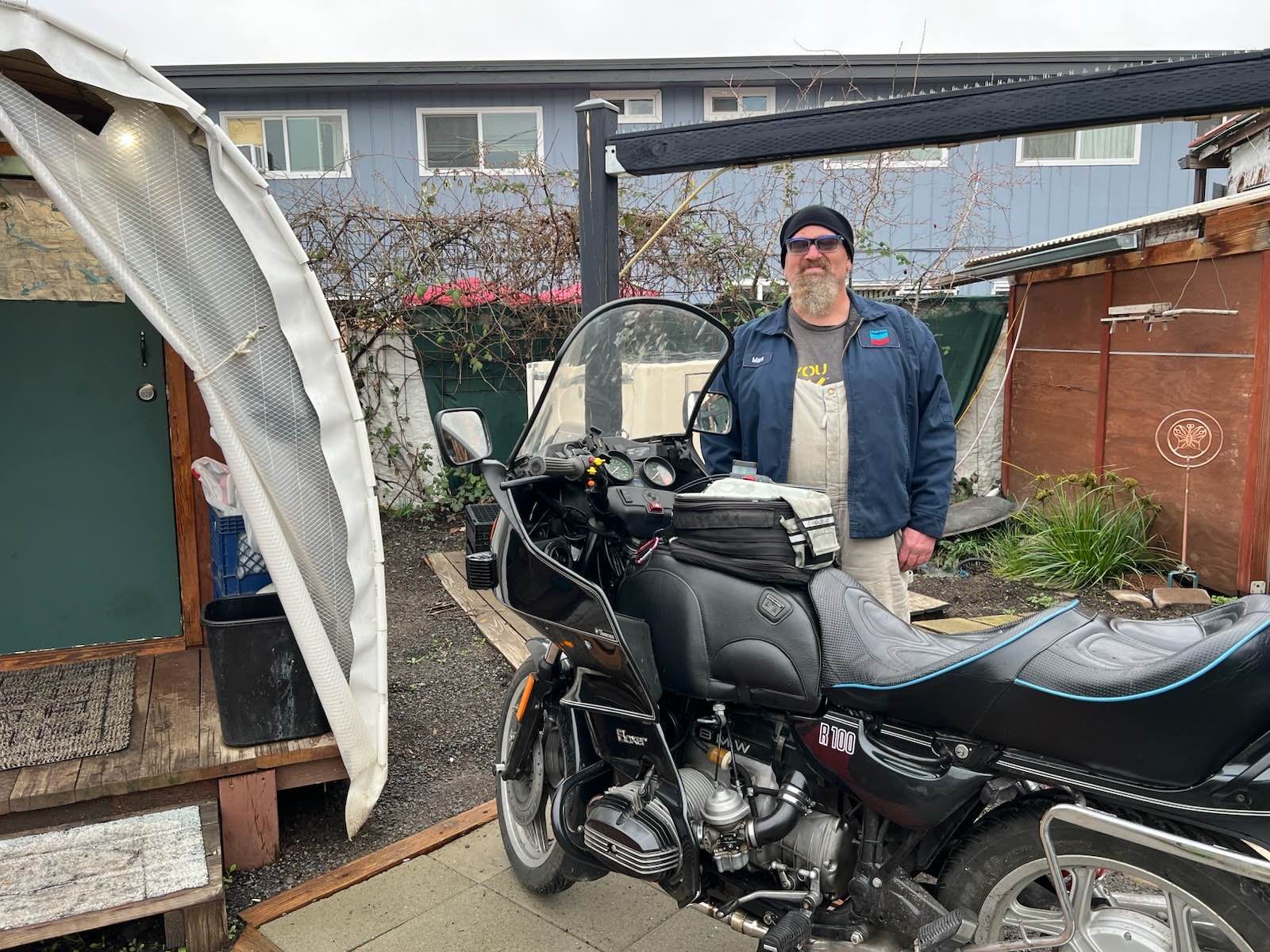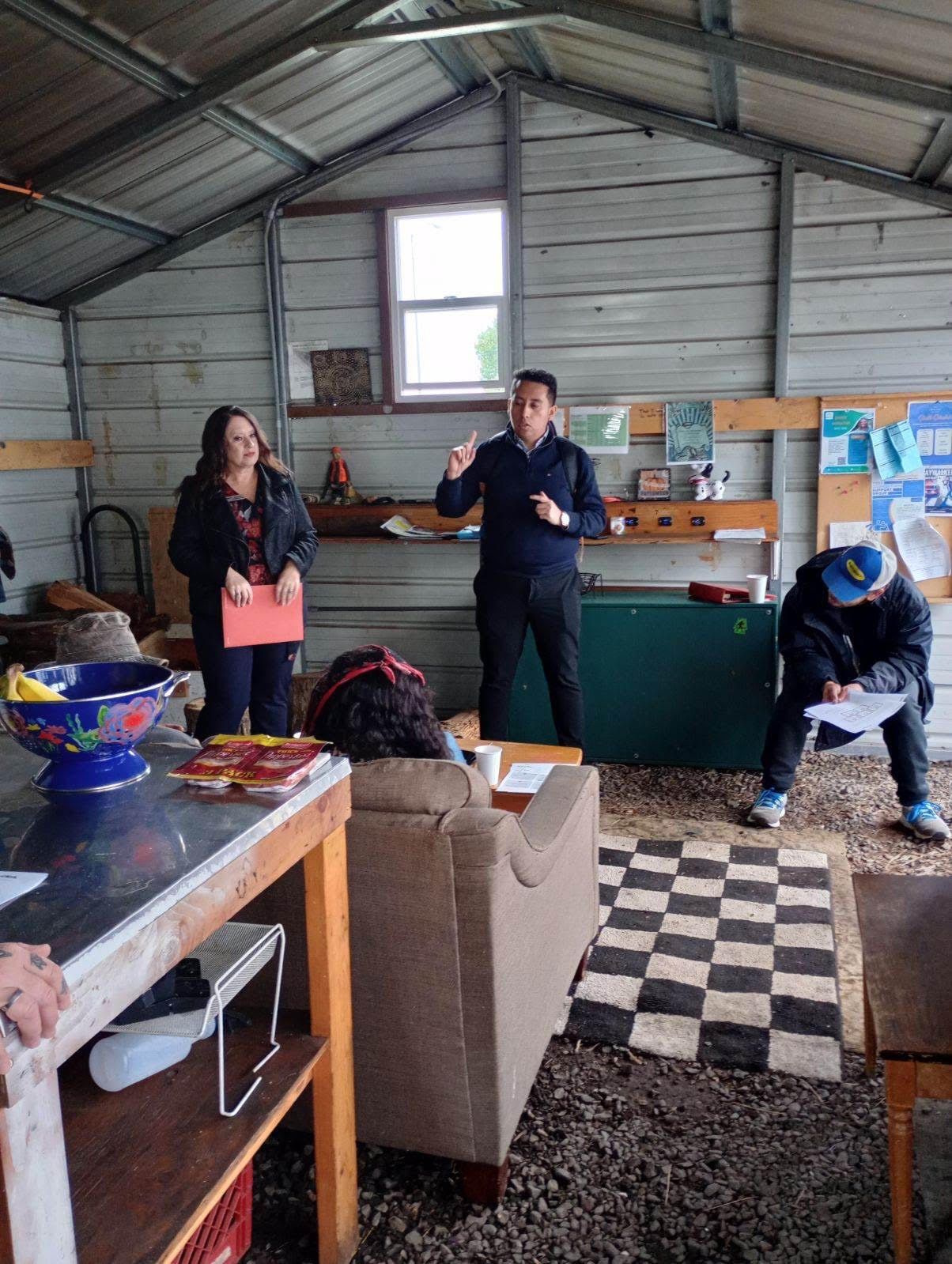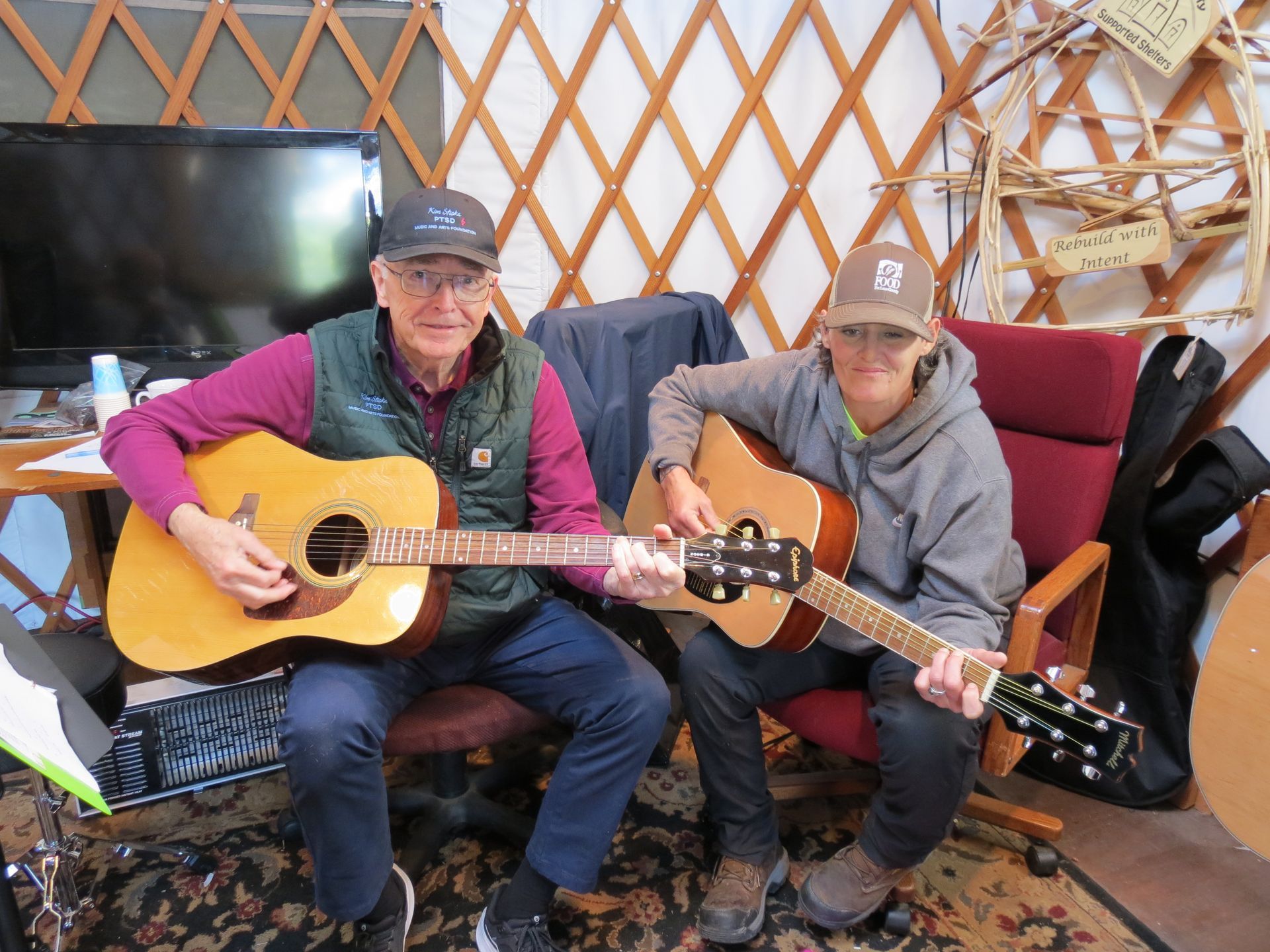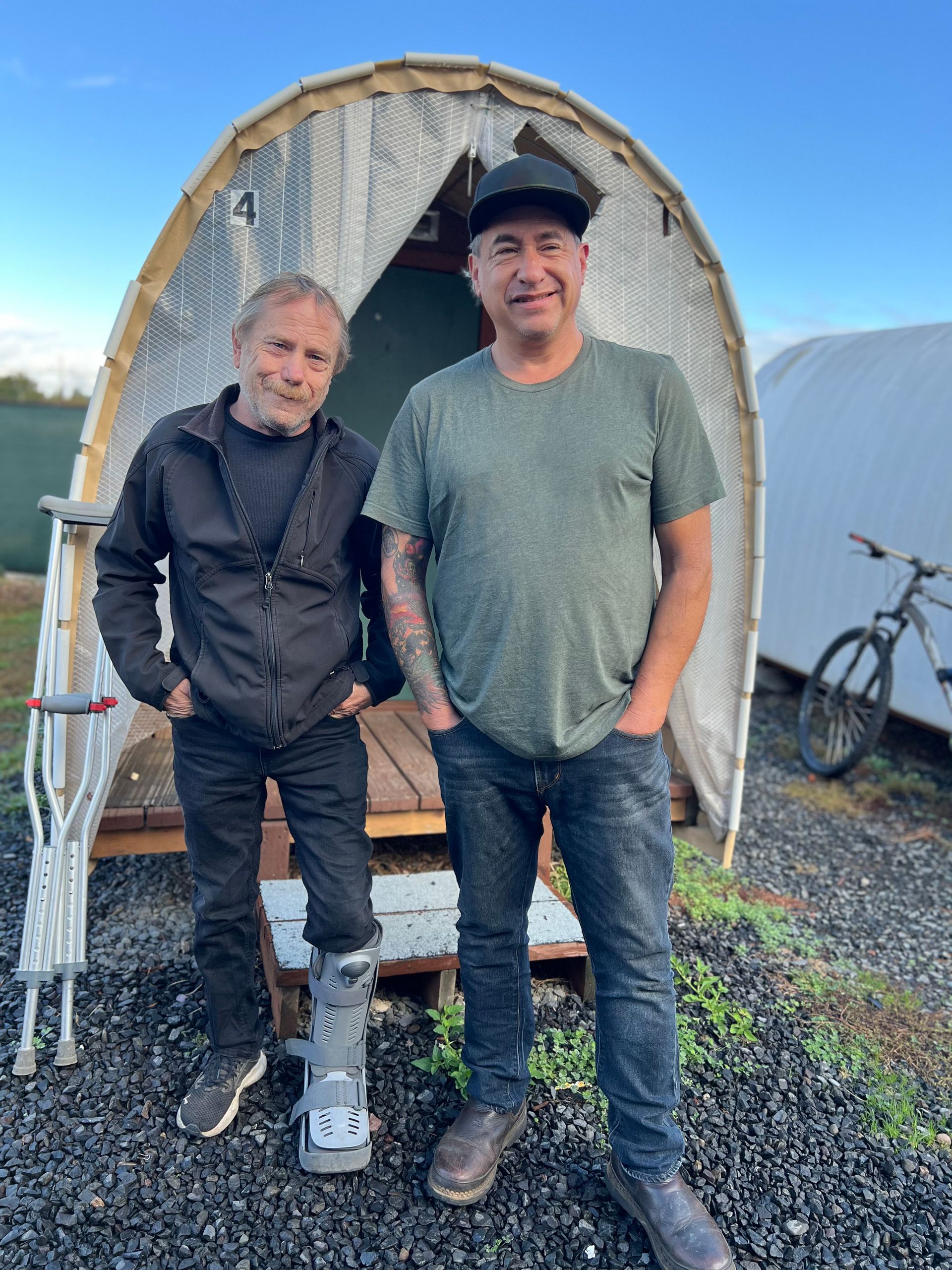Latanya Bell, 45, moved into the CSS vets camp with a former boyfriend about the time Matt was leaving for his apartment. The couple argued a lot and were put on probation. They passed that probationary period and were moved to the Roosevelt Safe Spot, but the troubles continued as her boyfriend was “coming off a lot of meds,” she says, “and he flipped, became a whole different person.”
While Latanya was in the Roosevelt camp, Fay de Buhr, CSS co-director, asked her to volunteer at the CSS office. She had clerical skills learned while working in a doctor’s office in the past, and her exuberant openness helped her connect easily with clients. She enjoyed that work. She and her boyfriend moved into a loft above the office. After three-and-a-half months there, she got word that her housing voucher had come through. They moved into the apartment building right next door.
That lasted 10 months, during which the police were called eight times for noise disturbances. Her boyfriend stopped going to his mental health appointments and taking his medications. He withdrew from volunteering at CSS and demanded that she stop, too. He’d come to the office and make a scene, she says. Eventually she stopped, too. “I wanted to stay,” she says. “I really did, but I just didn’t stand up to him.”
Her building’s landlord asked Latanya to give her 30-day notice of leaving the apartment, instead of being evicted and having that black mark on her record. But with help from a social service counselor at St. Vincent de Paul, Latanya found a new apartment—on the condition that her boyfriend was not allowed to live there until he started a program to address his problems. She was issued a voucher for a year at that apartment but only kept it for four months. It was the winter of 2016-17 when ice storms blanketed Eugene. Her ex-boyfriend, who had continued “stalking” her, was freezing on the streets and his mother called Latanya pleading with her to take him in.
“So I buckled, and I let him in,” she says. “That was a big mistake. When the ice started to melt, then he didn’t want to come down off that mountain.” Again, in February of last year, she was asked to give her 30-day notice instead of being evicted. She’s been homeless since then, spending some time at the Mission (from which, she says, she was kicked out for initiating a petition supporting a volunteer who wanted to make hot breakfasts for the women), in city parks, staying with friends, and, most recently, behind a restaurant where she keeps the parking lot clean.
Latanya describes her family as “a bunch of haters” and says her mother tried to kill her twice: “once before I was born, once after.”
Elaine Walters of the Trauma Healing Project says that “the earlier people experience trauma and other kinds of adversity, the longer term and more developmental the impact is.”
“One of the biggest challenges is those developmental gaps that people have to work around, and they may do alright when they’re in structured environments, but when they’re trying to make it on their own without that structure, it’s very difficult,” Elaine says. “The same people who are more likely to get hurt often have the least access to help to recover, so that’s a double whammy. Then when we don’t get good support to recover, we begin to show the signs of wear and tear and developmental gaps that get us targeted for very certain kinds of interventions that are mostly focused on managing our behavior, which ends up actually compounding and worsening the impact of the trauma.
“So, you’re more likely to get hurt, less likely to get help, and then more likely to get kicked when you’re down and misunderstood.”
Jean House, 63, and Severia Prince, 28, moved from the Roosevelt Safe Spot, where they shared a tent platform for about five months, into a two-bedroom apartment in Springfield last September. They’re doing fine, though they still have a few boxes to unpack.
Severia, who had been homeless off and on for seven years, says that moving into the apartment, at first, had a “shock factor” for her. “You’re not used to being able to take a nap whenever you want to,” she says. “You’re not used to being able to take a shower whenever you want to. It’s things you’re not used to that you have to re-get used to.”
Jean had been homeless for a relatively short amount of time, eight months, including her time in the Safe Spot. She had been living in a trailer that had no heat and no water and was without electricity for a while, while dealing with some serious health problems. Her doctor told her she had to get out—even if that meant she was homeless—or die. She stayed with family and friends for a while and then the CAHOOTS Hut at the Roosevelt camp for 15 days. After a short stint at the Mission, she went back to Roosevelt and the shared tent platform with Severia.
“I don’t think [moving to the apartment] was hard for me because I hadn’t been homeless that long, but some people have been homeless so long, the stability scares them,” Jean says.
“If you’ve been homeless for a long time, you’ve lost that routine of all the stuff you’ve got to do to maintain,” Severia say. “It’s almost like going to prison. You get institutionalized but it’s in a different way.”
Severia says her time at the Safe Spot helped in her transition.
“We had to work together at the camps to do stuff,” she says. “We made meals. we had coffee together in the morning and so it was kind of more like a home life than just being on the streets.”
“We were outside but we still had the companionship and the feeling of a family,” Jean says.
Their advice to others folks who have been homeless making the transition to stable housing: “Take your time. If you have case management, use it. If you don’t, make sure you’ve got all your ducks in a row. Try to just do the simple things that make up everyday life that a lot of homeless people aren’t used to, paying bills and doing grocery shopping to make sure you have food in the house.”
Some of those adjustments have been welcome. Recalling a freezing January morning when he had to use the bathroom at Alton Baker Park, which had stainless steel toilets with no seats and, on that morning, a thin layer of ice around the rim, he says, “I’m looking at that cold stainless steel rim with no seat, and I’m saying to myself ‘This isn’t going to feel good.’ Now, I’ve got a padded toilet seat, so, hey!”
Jeff had been on the waiting list through Housing and Community Services Agency of Lane County (HACSA now known as Homes for Good) for four years before being placed in his current home. St. Vincent de Paul’s Rapid Rehousing helped him to get his paperwork in during a brief period when HACSA had openings to accept applications. That window quickly closed.
Jeff earns some money collecting cans and makes sure to keep his counseling appointments. “I’m just going to keep doing what they’re asking.” he says.
He thinks one of the biggest mistakes made by individuals or agencies trying to help people experiencing homeless is to lump them into a few arbitrarily defined categories. “Every single person is an individual with different reasons and different causes,” he says, “and to try to box things in so narrowly is just wrong.”
“One of the great things about Community Supported Shelters is they take people on their own ability,” he says. “Not everybody has the same capability, and they’re willing to work with everybody.”
Even though getting people into housing doesn’t solve all their problems, it’s a necessary place to start, he says. “You have to get people into stable housing for them to make any more progress. That’s unfortunately true even with alcoholics and drug addicts. When they’re into stable housing their chances of recovery greatly increase.”
He knows of one formerly homeless woman who got evicted because she couldn’t get some paperwork to her landlord. “She just couldn’t bring herself to walk over there, some kind of phobia or fear, anxiety, and she wound up getting evicted over it, which was just stupid. Over just not turning in one little piece of paper. I can kind of understand that, in a way, but I’m not suffering like she was, not like that.”
It’s not a case of people getting too comfortable being homeless, he says, “I think they just give up.”
Vicki Goforth, 62, and Greg Blitz, 55, have also been in their apartment in central Eugene since January, after spending 4 months at the CSS’s Roosevelt camp. They had been homeless off-and-on, sometimes together, sometimes not, since Greg lost his job as a cab driver in Medford in July 2016. Greg had been on a Housing and Urban Development waiting list for a year but was given priority through the Veterans Administration because he is a navy veteran. They were persistent in seeking housing, checking in every week with the property manager of the complex where they now live.
Greg meets regularly with VA counselors and has put in a number of job applications. “We’re going to make it work. We’re going to get jobs,” Vicki says.
She didn’t have a problem with the transition to their new home. “I was just friggin’ happy,” she says. “Give me a door and close it and I’m happy.”
She’s grateful for the time they had at the Safe Spot and she enjoys it when some of the friends they made there stop by to visit: “And I’m saying, ‘you can do it. Try, go, put your best foot forward, keep trying. Don’t give up.’”
But sometimes people try and don’t make it. Matt and Latanya tried. But, unfortunately, many programs, even some with the best of intentions, don’t provide the help people most need, says Elaine Walters of the Trauma Healing Project. “You might call those challenges internal to the person but you might be better off noticing that the systems and the supports are not designed to help people recover, so . . . people tend to look worse over time and less able to function within the system that we’re trying to get them through.”
She believes that “housing first” can work for some people, but, she says, that there are few, if any, examples in Lane County “where people are given a home without a bunch of conditions.”
She says research backs up Jeff Howard’s observation on that subject. “When people get access to housing and basic needs without those heavy restrictions they actually tend to come off of drugs and other challenging coping strategies much more easily than when we put them in really restrictive situations.”
She stresses “meeting people where they’re at.”
“That doesn’t mean you don’t want to bring them back into connection and get people engaging in support and services, but I think the [best] approach is much slower.” Services that aren’t cognizant of an individual’s situation and are conditional can make it seem like those individuals “lost because they didn’t comply, when, in fact, the thing they were being forced to do wasn’t really considering their history or experience.”
Elaine says some of the elements of an approach most likely to help people would be
- Housing first where people are provided safe shelter and safe places to be,
- Giving them the opportunity to be part of a community,
- Listening to what people need, rather than telling them what they should do,
- Helping people identify what’s going to be hard for them in the transition and look for ways to build support around that,
- Offering opportunities for people to be engaged in activities and the leadership of their community, and
- Teach building managers and landlords to establish early and regular communications and reach clear agreements about expected behavior.
Both Matt and Latanya take responsibility for their current situation.
“I should have reached out more when I knew I was a danger to myself,” Matt says.
Latanya says she did not have a hard time with the transition to housing, but the relationship with her ex-boyfriend stymied her. “I was growing, but I was also regressing” because of that relationship, she says.
“I can’t look to a man,” Latanya says. “I have my support systems and if you’re having troubles with a man, he’s acting crazy or whatever, you already know what your girlfriend is going to say.”
She learned to stand up to her ex-boyfriend, she says. “It took me a few more years, but I did.”
“I don’t have that relationship issue now,” she says. “It’s okay, but as far as trying to get involved with somebody else—I really need to work on me.”
Latanya has worked a variety of jobs through her current stint of homelessness and, now, she is trying to get back into a CSS Safe Spot. “I would rather be living legally and have more structure,” she says.
Matt still stops by the CSS office every now and then but says he isn’t ready to try get back into a camp. “I won’t come back to the Vets camp until I know I can stay clean because it’s not fair bringing it into the camp.”
“I know exactly what I need to do,” he says, “and I’m just not ready to deal with those issues. One day, maybe, but . . .”
Although he talks about what he should have done differently, he does feel let down by the service agencies he was working with.
“Granted my story is not atypical,” he says, “but it does highlight some areas where both I and [some] organizations dropped the ball.”
“I was asking them [VA counselors] to help, to either remove me [from the apartment] or make it so everybody had to leave. They kept saying ‘okay, we’ll work with HACSA to move you,’ and both of the building managers that were there at the time—they changed right near the middle of this—kept saying ‘yeah, we’ll move you to a different unit; we’ll move you to a different complex.’ Nothing. I should have yelled and screamed for help instead of having quiet conversations, but there were at least four separate occasions, looking back, where I should have been institutionalized. And nobody cared.”
His advice to other people moving from homelessness to housing is hard won: “Stand your ground when you feel you need something. Don’t let it get swept under the rug. A closed mouth never gets fed.”
In the time after his daughter died, Matt filled six 120-page notebooks with his writing.
“I was just writing because I didn’t have anybody that I could talk to,” he says, “or who was willing to talk to me.”
He has recently been given three different journal books with lots of empty pages remaining.


